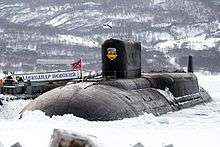Russian Armed Forces
The Armed Forces of the Russian Federation (Russian: Вооружённые Си́лы Росси́йской Федера́ции, tr. Vooruzhonnije Síly Rossíyskoj Federátsii), commonly known as the Russian Armed Forces, are the military forces of the Russian Federation, established after the dissolution of the Soviet Union.
| Armed Forces of the Russian Federation | |
|---|---|
| Вооружённые Си́лы Росси́йской Федера́ции Vooruzhonnije Síly Rossíyskoj Federátsii | |
.svg.png) Emblem of the Russian Armed Forces | |
.svg.png) Banner of the Russian Armed Forces | |
| Founded | 7 May 1992 |
| Service branches | |
| Headquarters | Ministry of Defence, Khamovniki District, Moscow |
| Leadership | |
| Supreme Commander-in-Chief | |
| Minister of Defence | |
| Chief of the General Staff | |
| Manpower | |
| Military age | 18–27 |
| Conscription | 12 months[1] |
| Active personnel | 900,000[2] (ranked 4th) |
| Reserve personnel | 2,000,000[2][Note 1] |
| Expenditures | |
| Budget | US$65.1 billion (2019)[3] (ranked 4th) |
| Percent of GDP | 3.9% (2019)[3] |
| Industry | |
| Domestic suppliers | |
| Annual exports | $19 billion (2018)[4][5] |
| Related articles | |
| History | Military history of Russia History of Russian military ranks Military ranks of the Soviet Union Wars involving Russia |
| Ranks | Army ranks Navy ranks Air Force ranks |
| Armed Forces of the Russian Federation |
|---|
.svg.png) |
| Staff |
| Services (vid) |
| Independent troops (rod) |
| Special operations force (sof) |
| Other troops |
|
| Ranks of the Russian Military |
| Uniforms of the Russian Military |
| History of the Russian military |
.jpg)
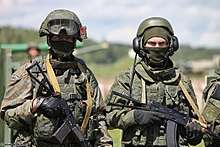
On 7 May 1992, Boris Yeltsin signed a presidential decree establishing the Russian Ministry of Defence and placing all Soviet Armed Forces troops on the territory of the Russian Soviet Federative Socialist Republic under Russian control.[6] The Commander-in-Chief of the Armed Forces is the President of Russia. The Russian Armed Forces were formed in 1992. It is the most powerful military in Europe, and is one of the world's largest military forces. According to Credit Suisse, Russia has the world's second-most powerful military.[7] The Russian Armed Forces also possess the largest stockpile of nuclear warheads in the world.[8]
Under Russian federal law, the Armed Forces along with the Federal Security Service (FSB)'s Border Troops, the National Guard, the Ministry of Internal Affairs (MVD), the Federal Protective Service (FSO), the Foreign Intelligence Service (SVR), and EMERCOM's civil defence form Russia's military services and are under direct control of the Security Council of Russia.
Service Branches
Armed forces under the Ministry of Defence are divided into:
- the three "branches of Armed Forces" (вида вооружённых сил): the Ground Forces, Aerospace Forces, and the Navy
- the two "separate troop branches" (Отдельные рода войск): the Strategic Missile Forces and the Airborne Troops
- the main "special forces of Armed Forces" (Спецназ вооружённых сил): the Special Operations Forces
- the Logistical Support, which has a separate status of its own
There are additionally two further "separate troop branches", the National Guard and the Border Service. These retain the legal status of "Armed Forces", while falling outside of the jurisdiction of the General Staff of the Armed Forces of the Russian Federation. The National Guard is formed on the basis of the former Internal Troops of Russia. The new structure has been detached from the Ministry of Internal Affairs into a separate agency, directly subordinated to the President of Russia. The Border Service is a paramilitary organization of the Federal Security Service - the country's main internal intelligence agency. Both organizations have significant wartime tasks in addition to their main peacetime activities and operate their own land, air and maritime units.
The number of personnel is specified by decree of the President of Russia. On 1 January 2008, a number of 2,019,629 units, including military of 1,134,800 units, was set.[9] In 2010 the International Institute for Strategic Studies (IISS) estimated that the Russian Armed Forces numbered about 1,027,000 active troops and in the region of 2,035,000 reserves (largely ex-conscripts).[10] As opposed to personnel specified by decree, actual personnel numbers on the payroll was reported by the Audit Chamber of Russia as 766,000 in October 2013.[11][12] As of December 2016, the armed forces are at 93 percent of the required manpower, up from 82 percent reported in December 2013.
According to the Stockholm International Peace Research Institute, between 2005-2009 and 2010–2014, Russian exports of major weapons increased by 37 percent;[13] Russia spent $66.4 billion on arms in 2015,[14] then $69.2 billion in 2016, having taken 3rd place (after the U.S. and China).[15] According to the Russian Defence Ministry, share of modern weapons in the Armed Forces reached from 26 to 48 percent among different kinds of troops in December 2014.[16] This was raised to 30.5–70.7% as of July 2015.[17] The average was 68.2 per cent over the end of 2019.[18][19][20]
History
The Soviet Union officially dissolved on 25 December 1991, leaving the Soviet military in limbo. For the next year and a half various attempts to keep its unity and to transform it into the military of the Commonwealth of Independent States (CIS) failed. Over time, some units stationed in the newly independent republics swore loyalty to their new national governments, while a series of treaties between the newly independent states divided up the military's assets.[21]
Apart from assuming control of the bulk of the former Soviet Internal Troops and the KGB Border Troops, seemingly the only independent defence move the new Russian government made before March 1992 involved announcing the establishment of a National Guard.[22] Until 1995, it was planned to form at least 11 brigades numbering 3,000 to 5,000 each, with a total of no more than 100,000. National Guard military units were to be deployed in 10 regions, including in Moscow (three brigades), (two brigades), and a number of other important cities and regions. By the end of September 1991 in Moscow the National Guard was about 15,000 strong, mostly consisting of former Soviet Armed Forces servicemen. In the end, President Yeltsin tabled a decree "On the temporary position of the Russian Guard", but it was not put into practice.[23]
After signing the Belavezha Accords on 21 December 1991, the countries of the newly formed CIS signed a protocol on the temporary appointment of Marshal of Aviation Yevgeny Shaposhnikov as Minister of Defence and commander of the armed forces in their territory, including strategic nuclear forces. On 14 February 1992 Shaposhnikov formally became Supreme Commander of the CIS Armed Forces. On 16 March 1992 a decree by Boris Yeltsin created The Armed Forces of the Russian Federation the operational control of Allied High Command and the Ministry of Defence, which was headed by President. Finally, on 7 May 1992, Yeltsin signed a decree establishing the armed forces and Yeltsin assumed the duties of the Supreme Commander.[24]
In May 1992, General Colonel Pavel Grachev became the Minister of Defence, and was made Russia's first Army General on assuming the post. By August or December 1993 CIS military structures had become CIS military cooperation structures with all real influence lost.[25]
In the next few years, Russian forces withdrew from central and eastern Europe, as well as from some newly independent post-Soviet republics. While in most places the withdrawal took place without any problems, the Russian Armed Forces remained in some disputed areas such as the Sevastopol naval base in the Crimea as well as in Abkhazia and in Transnistria. The Armed Forces have several bases in foreign countries, especially on territory of the former Soviet Republics.
A new military doctrine, promulgated in November 1993, implicitly acknowledged the contraction of the old Soviet military into a regional military power without global ambitions. In keeping with its emphasis on the threat of regional conflicts, the doctrine called for a smaller, lighter, and more mobile Russian military, with a higher degree of professionalism and with greater rapid-deployment capability. Such change proved extremely difficult to achieve. Under Pavel Grachev (Defence Minister from 1992 to 1996) little military reform took place, though there was a plan to create more deployable mobile forces. Later Defence Minister Rodionov (in office 1996-1997) had good qualifications but did not manage to institute lasting change. Only under Defence Minister Igor Sergeyev (in office 1997-2001) did a certain amount of limited reform begin, though attention focused upon the Strategic Rocket Forces.[26]
2008 military reform
Significant reforms were announced in late 2008 by Defence Minister Anatoliy Serdyukov (in office 2007-2012), and major structural reorganisation began in 2009. Key elements of the reforms announced in October 2008 included reducing the armed forces to a strength of one million by 2012 (planned end-date was 2016);[27] reducing the number of officers; centralising officer training from 65 military schools into 10 "systemic" military training centres; reducing the size of the central command; introducing more civilian logistics and auxiliary staff; elimination of cadre-strength formations; reorganising the reserves; reorganising the army into a brigade system; and reorganising air forces into an air-base system instead of regiments.[28] On 17 October 2012 the head of the State Duma's Defence Committee told RIA Novosti that Russia planned to boost annual defense spending by 59 percent to almost 3 trillion rubles ($83.3 billion) in 2015 up from $61 billion in 2012. "Targeted national defence spending as a percentage of GDP will amount to 3.2 percent in 2013, 3.4 percent in 2014 and 3.7 percent in 2015", Defence Committee chairman Vladimir Komoedov is quoted as saying in the committee's conclusion on the draft budget for 2013–2015.[29]
The number of military units is to be reduced in accordance with the table:[30]
| Arms and branches | 2008 | 2012 | Reduction |
|---|---|---|---|
| Ground Forces | 1,890 | 172 | -90 % |
| Air Force | 340 | 180 | -48 % |
| Navy | 240 | 123 | -49 % |
| Strategic Rocket Forces | 12 | 8 | -33 % |
| Space Forces | 7 | 6 | -15 % |
| Airborne Troops | 6 | 5 | -17 % |
_47.jpg)
An essential part of the military reform involves down-sizing. At the beginning of the reform the Russian Army had about 1,200,000 active personnel. Largely, the reductions fall among the officers. Personnel are to be reduced according to the table:[30]
| Rank | 1 September 2008 | 1 December 2009 | Planned for 2012 | Reduction |
|---|---|---|---|---|
| General/Admiral | 1,107 | 780 | 877 | −20.8 % |
| Colonel/Captain 1st Rank | 25,665 | 9,114 | −64.5 % | |
| Lieutenant Colonel/Captain 2nd Rank | 19,300 | 7,500 | −61 % | |
| Major/Captain 3rd Rank | 99,550 | 25,000 | −75 % | |
| Captain/Captain Lieutenant | 90,000 | 40,000 | −56 % | |
| First Lieutenant/Senior Lieutenant | 30,000 | 35,000 | +17% | |
| Lieutenant/Lieutenant | 20,000 | 26,000 | +30% | |
| Officers in total | 365,000 | 220,000 | −40 % | |
| Praporshchik/Warrant Officer | 90,000 | 0 | 0 | −100 % |
| Warrant officer | 50,000 | 0 | 0 | −100 % |
The schedule envisaged reducing the total numbers in the officer corps from 335 thousand to 150 thousand, but in early February 2011 Defence Minister Anatoly Serdyukov announced the decision to increase officers by 70,000 - to 220 thousand[31] to counteract this.
Structure
The Defence Ministry of the Russian Federation serves as the administrative body of the Armed Forces. Since Soviet times, the General Staff has acted as the main commanding and supervising body of the Russian armed forces: U.S. expert William Odom said in 1998, that 'the Soviet General Staff without the MoD is conceivable, but the MoD without the General Staff is not.'[32] However, currently the General Staff's role is being reduced to that of the Ministry's department of strategic planning, the Minister himself, currently Sergey Shoygu may now be gaining further executive authority over the troops. Other departments include the personnel directorate as well as the Logistical Support, Railway Troops, Signal Troops and Construction Troops. The Chief of the General Staff is currently General of the Army Valery Gerasimov.
The Russian military is divided into three services: the Russian Ground Forces, the Russian Navy, and the Russian Aerospace Forces. In addition there are two independent arms of service: the Strategic Missile Troops and the Russian Airborne Troops. The Armed Forces as a whole are traditionally referred to as the Army (armiya), except in some cases, the Navy is specifically singled out.
Military districts
Since late 2010 the Ground Forces as well as the Air Forces and Navy are distributed among four military districts: Western Military District, Southern Military District, Central Military District, and the Eastern Military District which also constitute four Joint Strategic Commands — West, South, Central, and East. Previously from 1992 to 2010, the Ground Forces were divided into six military districts: Moscow, Leningrad, North Caucausian, Privolzhsk-Ural, Siberian and Far Eastern and Russia's four fleets and one flotilla were organizations on par with the Ground Forces' Military Districts. These six MDs were merged into the four new MDs, which now also incorporate the air forces and naval forces. There is one remaining Russian military base, the 102nd Military Base, in Armenia left of the former Transcaucasus Group of Forces. It likely reports to the Southern Military District.
In mid-2010 a reorganisation was announced which consolidated military districts and the navy's fleets into four Joint Strategic Commands (OSC).[33] In 2014 the Northern Fleet was reorganized in separate Joint Strategic Command. Geographically divided, the five commands are:
- Joint Strategic Command West - Western Military District (HQ in St. Petersburg), includes the Baltic Fleet;
- Joint Strategic Command Northern Fleet - (HQ in Severomorsk);
- Joint Strategic Command South - Southern Military District (HQ in Rostov-on-Don) includes the Black Sea Fleet and Caspian Flotilla;
- Joint Strategic Command Center - Central Military District (HQ in Yekaterinburg);
- Joint Strategic Command East - Eastern Military District (HQ in Khabarovsk), includes the Pacific Fleet.
The plan was put in place on 1 December 2010 and mirrors a proposed reorganisation by former Chief of the General Staff Army General Yuri Baluyevsky for a Regional Command East which was not implemented.[34] The four commands were set up by a decree of President Medvedev on 14 July 2010.[35][36] In July 2011, an Operational-Strategic Command of Missile-Space Defence has also been established on the basis of the former Special Purpose Command of the Russian Air Force. A Presidential decree of January 2011 named commanders for several of the new organisational structures.[37]
Russian military command posts, according to globalsecurity.org, include Chekhov/Sharapovo about 80 kilometres (50 mi) south of Moscow, for the General Staff and President, Chaadayevka near Penza, Voronovo in Moscow, and a facility at Lipetsk all for the national leadership, Yamantau in the Urals, and command posts for the Strategic Rocket Forces at Kuntsevo in Moscow (primary) and Kosvinsky Mountain in the Urals (alternate).[38] It is speculated that many of the Moscow bunkers are linked by the special underground Moscow Metro 2 line.
Russian security bodies not under the control of the Ministry of Defence include the Internal Troops of the Ministry of Internal Affairs (now the National Guard of Russia's National Guard Forces Command), the Border Guard Service of Russia (part of the Federal Security Service), the Kremlin Regiment and the rest of the Federal Protective Service (Russia), and the Ministry of Emergency Situations, the country's civil defence service since 1995 and successor to earlier civil defence units.
Naval fleets
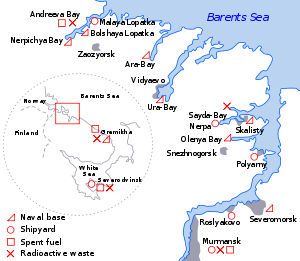
The Navy consists of four fleets and one flotilla:
- Northern Fleet (HQ at Severomorsk) forms own Joint Strategic Command.
- Baltic Fleet (HQ at Kaliningrad in the exclave of Kaliningrad Oblast) subordinated to Joint Strategic Command West.
- Black Sea Fleet (HQ at Sevastopol, disputed region of Crimea) subordinated to Joint Strategic Command South.
- Pacific Fleet (HQ at Vladivostok) subordinated to Joint Strategic Command East.
- Caspian Flotilla (HQ at Astrakhan) subordinated to Joint Strategic Command South.
The Kaliningrad Special Region, under the command of the Commander Baltic Fleet, comprises Ground & Coastal Forces, formerly the 11th Guards Army, with a motor rifle division and a motor rifle brigade, and a fighter aviation regiment of Sukhoi Su-27 'Flanker', as well as other forces.
Similarly, the Northeast Group of Troops and Forces, headquartered at Petropavlovsk-Kamchatskiy, comprises all Russian Armed Forces components in the Kamchatka Krai and the Chukotka Autonomous Okrug [district] and is subordinate to the Commander Pacific Fleet headquartered in Vladivostok.
Personnel
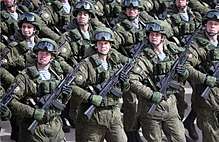

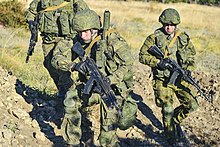
Conscription is still used in Russia; the term of service being 12 months; and eligible age is between 18 and 33 years old. Deferments are provided to undergraduate and graduate students, men solely supporting disabled relatives, parents of at least two children and — upon Presidential proclamation — to some employees of military-oriented enterprises. Men holding a Ph.D., as well as sons and brothers of servicemen killed or disabled during their military service, are released from conscription.
There are widespread problems with hazing in the Army, known as dedovshchina, where first-year draftees are bullied by second-year draftees, a practice that appeared in its current form after the change to a two-year service term in 1967.[39] According to Anna Politkovskaya, in 2002, "a complete battalion, more than five hundred men, had been killed not by enemy fire but by beatings".[40] To combat this problem, a new decree was signed in March 2007, which cut the conscription service term from 24 to 18 months. The term was cut further to one year on 1 January 2008.[41][42]
Thirty percent of Russian Armed Forces' personnel were contract servicemen at the end of 2005.[43] For the foreseeable future, the Armed Forces will be a mixed contract/conscript force.[43] The Russian Armed Forces need to maintain a mobilization reserve to have manning resources capable of reinforcing the permanent readiness forces if the permanent readiness forces cannot deter or suppress an armed conflict on their own.[44] Professional soldiers now outnumber their conscript counterparts in the Russian Army for the first time in Russian history, Defence Minister Sergei Shoigu told Russian media on 28 April 2015.[45] Nearly 400,000 contractors serve in the Russian Army as of March 2019. According to Defence Minister Shoigu, in every regiment and brigade, two battalions are formed by contractors, while one is formed by recruits, who are not involved in combat missions. Currently, there are 136 tactical battalion groups in the armed forces formed by contractors.[46] The number of conscripts amounts to 225,000 and the number of contractors amounts to 405,000 as of March 2020.[47]
Recruitment into the Russian military are also open to non-Russian citizens of the Commonwealth of Independent States, of which Russia is the largest member.[48] By December 2003, the Russian parliament had approved a law in principle to permit the Armed Forces to employ foreign nationals on contract by offering them Russian citizenship after several years service[49] yet, up to 2010, foreigners could only serve in Russia's armed forces after getting a Russian passport. Under a 2010 Defence Ministry plan, foreigners without dual citizenship would be able to sign up for five-year contracts and will be eligible for Russian citizenship after serving three years.[50][51] The change could open the way for CIS citizens to get fast-track Russian citizenship, and counter the effects of Russia's demographic crisis on its army recruitment. Each soldier in duty receives an Identity Card of the Russian Armed Forces.
Awards and decorations of the Armed Forces are covered at the Awards and Emblems of the Ministry of Defence of the Russian Federation.
On 17 November 2011, General Nikolai Makarov said that Russia had reached a crisis in the conscript service where there simply were not sufficient able bodied men to draft and was forced to halve its conscription.[52] Military draft dodging declined 66% since 2012 and as of March 2019. It is reported that about 80% of the young people who were drafted into the ranks of the Russian Armed Forces in the autumn of 2018 were found fit for military service. According to the head of the mobilization, in recent years, the fitness of future recruits has increased by 7%.[53]
In March 2013, Defence Minister Sergey Shoygu promised that all army quarters would have showers by the end of the year.[54] RIA also said that the shower plans were the latest in a series of creature-comfort improvements the Defence Ministry had recently announced. In mid-January, Shoygu said he would rid the army of its antiquated "footwraps," or portyanki, and a few days later the designer of Russia's new army uniform said that the ear-flap hats traditionally worn in winter would be replaced with more modern headgear. The Russian military's ushanka hats were improved between 2013 and 2015, when the Russian armed forces were being equipped with new uniforms. The new version of the traditional - and somewhat stereotypical - hat features better heat insulation and longer ear flaps.[55]
Russian military officers with top secret security clearance are now being issued domestically developed, ultra-secure, cryptographically protected Atlas M-663S cellphones, Russia's Izvestia newspaper has reported in early 2018.[56] A new uniform for hot climates was introduced in mid-2018.[57]
Reserve components
According to the article 51.2 of Federal Law of 28 March, 1998, No.53-FZ "About military duty and military service", Russian Armed Forces have reserve (Russian: запас; transliteration: zapas) which includes 2 components:[58]
- Mobilization human reserve (Russian: мобилизационный людской резерв; transliteration: mobilizatsionnyy lyudskoy reserv)
- Mobilization human resource (Russian: мобилизационный людской ресурс; transliteration: mobilizatsionnyy lyudskoy resurs)
By default, at the end of active duty each military personnel is enrolled in mobilization human resource; this applies equally to conscripts and volunteers regardless of ranks. Furthermore, graduates of civilian institutions of higher education, who have graduated the military training centers of their almae matres, trained under reserve officer program, is enrolled in mobilization human resource after their promotion to officer's rank (unlike graduates of such centers, trained under active duty officer program, who are due to be enrolled for active duty after their promotion to officer's rank). Moreover, mobilization human resource is replenished with males who reached the age of 27 years old and, herewith, was not in military service for any reasons.
Enrolling in mobilization human reserve is voluntary and implies the special contract; this possibility is available for each persons, who is in mobilization human resource already.[59] The initial contract is concluded for 3 years period. Military personnel of mobilization human reserve (reservists) perform part-time duties in military units.[60] As a rule, in peaceful time reservists perform their duties 2-3 days per month and also during annual military camp training for a duration from 20 to 30 days.[61]
The persons who are in mobilization human resource (non-reservists) may be enlisted to military camp trainings in peaceful time. According to the article 54 of Federal Law of 28 March, 1998, No.53-FZ "About military duty and military service", the duration of each training can not exceed 2 months, herewith the total duration of such trainings for the entire period of being in mobilization human resource can not exceed 12 months, and person may be enlisted to such trainings no more than once every three years.[62]
Reservists are subject to mobilization in wartime first of all. Non-reservists are subject to mobilization secondarily. Mobilization of non-reservists is carried out taking into account the age category under the article 53 of Federal Law of 28 March, 1998, No.53-FZ "About military duty and military service": in order from first category to third category. The first category includes: 1) the persons at the any military rank below that of a commissioned officer (enlisted personnel) and not reached the age of 35 years old; 2) the persons at the any rank from junior lieutenant to captain (captain-lieutenant in naval service) inclusively (junior commissioned officers) and not reached the age of 50 years old; 3) the persons at the any rank from major (captain 3rd rank in naval service) to lieutenant colonel (captain 2nd rank in naval service) inclusively and not reached the age of 55 years old; 4) the persons at the rank of colonel (captain 1st rank in naval service) and not reached the age of 60 years old; 5) the persons at the rank of major general (counter admiral in naval service) or higher (supreme officers) and not reached the age of 65 years old. The second category includes: 1) enlisted personnel in age from 35 but less than 45; 2) junior commissioned officers in the age from 50 but less than 55; 3) commissioned officers at the any rank from major (captain 3rd rank in naval service) to lieutenant colonel (captain 2nd rank in naval service) inclusively in the age from 55 but less than 60; 4) commissioned officers at the rank of colonel (captain 1st rank in naval service) in the age from 60 but less than 65; 5) supreme officers in age from 65 but less than 70. The third category includes: 1) enlisted personnel in the age from 45 but less than 50; 2) junior commissioned officers in the age from 55 but less than 60; 3) commissioned officers at the any rank from major (captain 3rd rank in naval service) to lieutenant colonel (captain 2nd rank in naval service) inclusively in the age from 60 but less than 65; 4) all females in the age less than 45 for enlisted personnel and less than 50 for commissioned officers. The person who has reached the age limit, established for the third category (the second category for persons at the rank of colonel (captain 1st rank in naval service) or higher), is retired and is not subject to mobilization.[63][64]
Budget
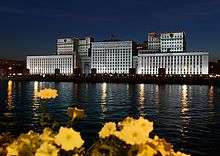
_1.jpeg)
Between 1991 and 1997 newly independent Russia's defence spending fell by a factor of eight in real prices.[65] In 1998, when Russia experienced a severe financial crisis, its military expenditure in real terms reached its lowest point— barely one-quarter of the USSR's in 1991, and two-fifths of the level of 1992, the first year of Russia's independent existence.
In the early 2000s, defence spending increased by at least a minimum of one-third year-on-year, leading to overall defence expenditure almost quadrupling over the past six years, and according to Finance Minister Alexei Kudrin, this rate is to be sustained through 2010.[66] Official government military spending for 2005 was US$32.4 billion, though various sources, have estimated Russia's military expenditures to be considerably higher than the reported amount.[67] Estimating Russian military expenditure is beset with difficulty; the annual IISS Military Balance has underscored the problem numerous times within its section on Russia.[67] The IISS Military Balance comments - 'By simple observation..[the military budget] would appear to be lower than is suggested by the size of the armed forces or the structure of the military–industrial complex, and thus neither of the figures is particularly useful for comparative analysis'.[68] By some estimates, overall Russian defence expenditure is now at the second highest in the world after the USA.[69] According to Alexander Kanshin, Chairman of the Public Chamber of Russia on affairs of veterans, military personnel, and their families, the Russian military is losing up to US$13 billion to corruption every year.[70]
On 16 September 2008 Russian Prime Minister Vladimir Putin announced that in 2009, Russia's defence budget would be increased to a record amount of $50 billion.[71][72]
On 16 February 2009 Russia's deputy defence minister said state defence contracts would not be subject to cuts this year despite the ongoing financial crisis, and that there would be no decrease in 2009.[73] The budget would still be 1,376 billion roubles and in the current exchange rates this would amount to $41.5 billion.
However, later that month, due to the world financial crisis, the Russian Parliament's Defence Committee stated that the Russian defence budget would instead be slashed by 15 percent, from $40 billion to $34 billion, with further cuts to come.[74] On 5 May 2009, First Deputy Prime Minister Sergei Ivanov said that the defence budget for 2009 will be 1.3 trillion rubles (US$39.4 billion). 322 billion rubles are allocated to purchase weapons, and the rest of the fund will be spent on construction, fuel storage and food supply. According to the head of the Defence Committee of the State Duma Vladimir Komoyedov, Russia plans to spend 101.15 billion rubles on nuclear weapons in 2013–2015. "The budget provisions under 'The Nuclear Weapons Complex' section in 2013-2015 will amount to 29.28 billion rubles, 33.3 billion rubles and 38.57 billion rubles respectively," Komoyedov said, Vechernaya Moskva reports.
Komoyedov added that in 2012 the spending on nuclear weapons made up 27.4 billion rubles. The draft law "On the Federal Budget for 2013 and for the planning period of 2014 and 2015" will be discussed in the first reading on 19 October 2012, The Voice of Russia reports.[75] In a meeting in Sochi in November 2013, President Putin said the country's defence budget will reach 2.3 trillion roubles, stressing the huge amount in comparison to the 2003 budget, which stood on 600 billion rubles.[76]

The Russian government's published 2014 military budget is about 2.49 trillion rubles (approximately US$69.3 billion), the fourth largest in the world behind the US, China and Saudi Arabia. The official budget is set to rise to 3.03 trillion rubles (approximately US$83.7 billion) in 2015, and 3.36 trillion rubles (approximately US$93.9 billion) in 2016.[77] As of 2014, Russia's military budget is higher than any other European nation, and approximately 1/7th (14 percent) of the US military budget. In 2015, SIPRI found that Russia was the world's second biggest exporter of major weapons for the period 2010–14, increasing exports by 37 per cent. India, China and Algeria accounted for almost 60 percent of total Russian exports. Asia and Oceania received 66 percent of Russian arms exports in 2010–14, Africa 12 percent and the Middle East 10 percent.[13]
In 2017, Russia was reported to have slashed its defense spending by 20%, due to calls by Vladimir Putin to spend money on other initiatives such as healthcare and education. The cut decreased Russia's military spending to $66.3 billion, in which Russia slumped to being the fourth-highest military spender.[78] Russia's 2019 defense budget was US$48 billion.[79]
Procurement
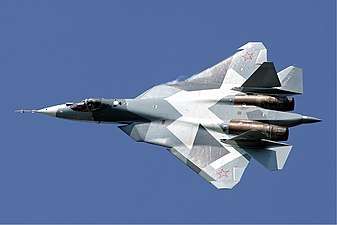
About 70 percent of the former Soviet Union's defence industries are located in the Russian Federation.[80] Many defence firms have been privatised; some have developed significant partnerships with firms in other countries.
The recent steps towards modernization of the Armed Forces have been made possible by Russia's economic resurgence based on oil and gas revenues as well a strengthening of its own domestic market. Currently, the military is in the middle of a major equipment upgrade, with the government in the process of spending about $200 billion (what equals to about $400 billion in PPP dollars) on development and production of military equipment between 2006-2015 under the State Armament Programme for 2007-2015 (GPV — госпрограмма вооружения).[81] Mainly as a result of lessons learned during the Russo-Georgian War, the State Armament Programme for 2011-2020 was launched in December 2010. Prime Minister Putin announced that 20–21.5 trillion rubles (over $650 billion) will be allocated to purchase new hardware in the next 10 years. The aim is to have a growth of 30% of modern equipment in the army, navy and air force by 2015, and of 70% by 2020.[82][83][84][85] In some categories, the proportion of new weapon systems will reach 80% or even 100%.[86] At this point, the Russian MoD plans to purchase, among others, up to 250 ICBMs, 800 aircraft, 1,200 helicopters, 44 submarines, 36 frigates, 28 corvettes, 18 cruisers, 24 destroyers, 6 aircraft carriers, and 62 air defence battalions. Several existing types will be upgraded.[86][87] The share of modern and advanced weapons in some branches of the Russian Armed Forces currently amounts over 60 percent, the Defence Ministry reported 31 July 2015.[88]
In total since 2012 and as of 2017, the Armed Forces received more than 30,000 units of new and modernized weapons and equipment, including more than 50 warships, 1,300 aircraft, over 1,800 drones, 4,700 tanks and armored combat vehicles compared to two warships, 151 aircraft and 217 tanks received in 2007–2011. The Russian army also receives 150-250 aircraft per year and over 300 short-range UAVs.[89][90][19]
The Russian Federation is also producing satellite-guided weapons, drones (including combat and kamikaze ones and quadrocopters) and EW systems to counter them, cruise missiles, unmanned vehicles, exoskeletons and military robots and other military equipment.
[91][92][93][94][91][95][91][96][97][98][99][100][101][102][103][104][105][106][107][108][109][110][111][112][113][114][115][116][117][118][119][120][121][122][123][124][125][126][127][128][129][130]
As of 2011, Russia's chief military prosecutor said that 20 percent of the defence budget was being stolen or defrauded yearly.[131]
In 2018, RF Armed Forces adopted 35 types of weapons and military equipment and completed state tests of 21 more.[132] The Russian Ministry of Defence (MoD) was procured the YeSU TZ (Yedinaya Sistema Upravleniya Takticheskogo Zvena) battlefield management system that same year. The YeSU TZ battlefield management system incorporates 11 subsystems that control artillery, electronic warfare systems, ground vehicles, air defence assets, engineering equipment, and logistics support, among other things.[91] Russian military introduce Big Data decision-making technology.[133]
12 missile regiments have been rearmed with Yars ICBMs, 10 missile brigades with Iskander tactical ballistic missile systems, 13 aviation regiments with MiG-31BM, Su-35S, Su-30SM, and Su-34 combat aircraft, three army aviation brigades and six helicopter regiments with Mi-28N and Ka-52 combat helicopters, 20 surface-to-air missile (SAM) regiments with S-400 Triumf SAM systems, 23 batteries with Pantsir-S self-propelled anti-aircraft gun-missile systems, and 17 batteries with Bal and Bastion mobile coastal defence missile systems [MCDMSs] since 2012 and as of March 2019.[91]
Since 2012 and as of March 2020, the Ground Forces have received more than 12,000 pieces of weapon systems and equipment and rearmed all missile brigades with the Iskander tactical ballistic missile system. Aerospace Force and naval aviation have received over 1,400 aircraft and helicopters and the Navy more than 190 ships, vessels and boats.[134]
Nuclear weapons
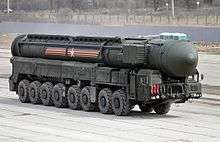
As of January 2017, the Federation of American Scientists estimated that Russia has approximately 1,765 deployed strategic warheads, and another 2,700 non-deployed strategic and deployed and non-deployed tactical warheads, plus an additional 2,510 warheads awaiting dismantlement.[135] Russia's Strategic Rocket Forces controls its land-based nuclear warheads, while the Navy controls the submarine based missiles and the Air Force the air-launched warheads. Russia's nuclear warheads are deployed in four areas:
- Land-based immobile (silos), like R-36 and its replacement RS-28 Sarmat.
- Land-based mobile, like RT-2PM2 Topol-M and new RS-24 Yars.
- Submarine based, like R-29RMU2 Layner and RSM-56 Bulava.
- Air-launched warheads of the Russian Air Forces' Long Range Aviation Command
The military doctrine of Russia sees NATO expansion as one of the threats for the Russian Federation and reserves the right to use nuclear weapons in response to a conventional aggression that can endanger the existence of the state. In keeping with this, the country's nuclear forces received adequate funding throughout the late 1990s. The number of intercontinental ballistic missiles and warheads on active duty has declined over the years, in part in keeping with arms limitation agreements with the U.S. and in part due to insufficient spending on maintenance, but this is balanced by the deployment of new missiles as proof against missile defences. Russia has developed the new RT-2PM2 Topol-M (SS-27) missiles that are stated to be able to penetrate any missile defence, including the planned U.S. National Missile Defence. The missile can change course in both air and space to avoid countermeasures. It is designed to be launched from land-based, mobile TEL units.[136] Russian nuclear forces are confident that they can carry out a successful retaliation strike if attacked.
Because of international awareness of the danger that Russian nuclear technology might fall into the hands of terrorists or rogue officers who it was feared might want to use nuclear weapons to threaten or attack other countries, the federal government of the United States and many other countries provided considerable financial assistance to the Russian nuclear forces in the early 1990s. Many friendly countries gave huge amounts of money in lieu for Russian Arms purchase deals which kept Russian Agencies functioning. This money went in part to finance decommissioning of warheads under international agreements, such the Cooperative Threat Reduction programme, but also to improve security and personnel training in Russian nuclear facilities.
In the late evening of 11 September 2007 the fuel-air explosive AVBPM or "Father of All Bombs" was successfully field-tested.[137] According to the Russian military, the new weapon will replace several smaller types of nuclear bombs in its arsenal.
See also
Notes
- The potential reserve personnel of Russia may be as high as 20 million, depending on how the figures are counted. However, an est. 2 million have seen military service within the last 5 years.
References
- Masters, Jonathan (28 September 2015). "The Russian Military". Council on Foreign Relations. Archived from the original on 17 September 2017. Retrieved 17 August 2017: This source cites the IISS Military Balance for 2014.
- International Institute for Strategic Studies (15 February 2019). The Military Balance 2019. Routledge. p. 195. ISBN 978-1857439885.
- Tian, Nan; Fleurant, Aude; Kuimova, Alexandra; Wezeman, Pieter D.; Wezeman, Siemon T. (27 April 2020). "Trends in World Military Expenditure, 2019" (PDF). Stockholm International Peace Research Institute. Retrieved 27 April 2020.
- AFP, French Press Agency- (7 February 2018). "Russia exported $15 billion worth of weapons in 2017". Daily Sabah.
- Times, The Moscow (1 November 2018). "Russia's Arms Exporter Sold $19Bln Worth of Weapons in 2018, Official Says". The Moscow Times.
- Greg Austin & Alexey Muraviev, The Armed Forces of Russia in Asia, Tauris, 2000, p.130
- O’Sullivan, Michael; Subramanian, Krithika (17 October 2015). The End of Globalization or a more Multipolar World? (Report). Credit Suisse AG. Archived from the original on 15 February 2018. Retrieved 14 July 2017.
- "Status of World Nuclear Forces – Federation Of American Scientists". Fas.org. Retrieved 2 July 2020.
- Указ Президента РФ от 1 января 2008 г. № 1 "О штатной численности Вооруженных Сил Российской Федерации" [RF Presidential Decree on 1 January 2008 № 1 "On the authorised strength of the Armed Forces"]. Garant.ru (in Russian). 6 February 2008. Archived from the original on 5 March 2016. Retrieved 1 March 2016.
- IISS Military Balance 2010, p. 222
- "766,055". RIA Novosti. 31 October 2013. Archived from the original on 14 April 2017. Retrieved 13 April 2017 – via russiandefpolicy.blog.
- Почти четверть должностей в ВC РФ были вакантными на начало года [Almost a quarter of positions in the Armed Forces of the Russian Federation were vacant at the beginning of the year] (in Russian). RIA Novosti. 24 October 2013. Archived from the original on 14 April 2017. Retrieved 13 April 2017.
- "Trends in International Arms Transfer, 2014". www.sipri.org. Stockholm International Peace Research Institute. Archived from the original on 19 March 2015. Retrieved 18 March 2015.
- Perlo-Freeman, Sam; Aude Fleurant; Pieter Wezeman; Siemon Wezeman (April 2016). "Trends in World Military Expenditure, 2015" (PDF). Stockholm International Peace Research Institute. Archived from the original (PDF) on 20 April 2016. Retrieved 23 August 2016.
- Россия вышла на третье место в мире по объему военных расходов, оттеснив Саудовскую Аравию Archived 24 April 2017 at the Wayback Machine NEWSru, 24 April 2017.
- Шойгу: оснащенность Российской армии современным оружием и техникой за год выросла на 7% [Shoygu: the equipping of the Russian army with modern weapons and technology increased by 7% over the year] (in Russian). Tass.ru. 19 December 2014. Archived from the original on 5 March 2016. Retrieved 23 August 2016.
- "Putin holds single day of military products' acceptance, modern weapons share up to 70%". TASS. 16 July 2015. Archived from the original on 14 April 2017. Retrieved 14 April 2017.
- "Almost 60% of Russian Armed Forces Armed With Advanced Weapons - General Staff". Sputniknews.com. 23 March 2017. Archived from the original on 19 June 2017. Retrieved 27 May 2017.
- "Russian army gets 1,500 weapon titles, 80,000 pieces of equipment 2018 - Military & Defense". TASS. Retrieved 9 June 2020.
- "Russian Army boosts its combat potential in 2019, defense chief says - Military & Defense". TASS. Retrieved 9 June 2020.
- For an account of this period, see Odom, William E. (1998). The Collapse of the Soviet Military. Yale University Press. ISBN 0-300-07469-7.
- For some early discussion on this period, see Richard Woff, "A Russian Army", Jane's Intelligence Review, May 1992, 198-200. See also Voenniy vestnik No 12, 1991.
- "Short life of the new Russian Guard". Tsiganok.ru. 21 December 2006. Retrieved 24 March 2014.
- Министерство обороны Российской Федерации [Ministry of Defence of the Russian Federation] (in Russian). Politika.su. Archived from the original on 21 December 2012. Retrieved 24 March 2014.
- The Staff for Coordinating Military Cooperation was established as the CIS Joint Armed Forces High Command in March 1992 and then reorganised as the Coordinating Staff in August 1993. It quickly became a very weak body as the new states' authorities asserted their control over their own armed forces. (Russia and NIS Mineral Industry Handbook, International Business Publications, 2007.) Army General Vladimir Yakovlev (general) appears to have become Chief of the Staff in June 2001 (DS2002-0819).
- Parchomenko, Walter (Winter 1999–2000). "The State of Russia's Armed Forces and Military Reform". Parameters: the U.S. Army's senior professional journal. ssi.armywarcollege.edu: 98–110. ISSN 0031-1723. Archived from the original on 10 December 2016. Retrieved 17 August 2017.
- "Russia's top brass gather in Moscow to discuss military reform". En.rian.ru. 2 September 2009. Archived from the original on 3 September 2009. Retrieved 24 March 2014.
- Moscow Defence Brief, 20 (2), 2010
- "Russia to Boost Defense Spending 59% by 2015". RIA Novosti. 17 October 2012. Archived from the original on 1 January 2013. Retrieved 23 March 2014.
'Targeted national defense spending as a percentage of GDP will amount to 3.2 percent in 2013, 3.4 percent in 2014 and 3.7 percent in 2015,' Defense Committee chairman Vladimir Komoedov is quoted as saying in the committee's conclusion on the draft budget for 2013-2015.
- "Reform of the Russian Armed Forces". En.rian.ru. Archived from the original on 22 January 2012. Retrieved 24 March 2014.
- "16.01.12 Реформа ВС РФ повысила эффективность авиации — командир авиагруппы ВВС — Военный паритет". Militaryparitet.com. Archived from the original on 23 March 2014. Retrieved 23 March 2014.
- William Eldridge Odom, 'The Collapse of the Soviet Military,' Yale University Press, 1998, p.27
- Wallace, Andrew (27 May 2010). "New military command structure and outsourcing initiatives". THE ISCIP ANALYST (Russian Federation) An Analytical Review. Boston University. XVI (13). Archived from the original on 21 October 2012.
- Golts, Alexsander (20 July 2010). "3 Heads are worse than one". The Moscow Times. Archived from the original on 22 July 2010.
- "Russia sets up four strategic commands". RIA Novosti. 14 July 2010. Archived from the original on 16 July 2010.
- "Russia's regional military commands". RIA Novosti. September 2010. Archived from the original on 6 December 2011.
- Кадровые изменения в Вооружённых Силах [Staffing changes in the Armed Forces] (in Russian). Presidential Administration of Russia. 9 January 2011. Archived from the original on 12 January 2011. Retrieved 23 March 2014.
- "Strategic C3I Facilities". globalsecurity.org. 2000. Archived from the original on 12 January 2003.
- Odom, The Collapse of the Soviet Military
- Politkovskaya, Anna (2007). Putin's Russia: Life in a Failing Democracy. Henry Holt and Company. p. 2. ISBN 978-1-4299-3915-7.
- "History of Russian Armed Forces started with biggest military redeployment ever". Pravda. 7 May 2007. Archived from the original on 12 May 2007.
- Giles, Keir (2006). Where have all the soldiers gone?: Russia's military plans versus demographic reality (PDF). Conflict Studies Research Centre. ISBN 978-1-905058-92-1. Retrieved 14 April 2017: Explores some of the challenges of the March 2007 transition to the new approach to deployment.
- Central Intelligence Agency, The World Fact Book: Russia Archived 3 July 2015 at the Wayback Machine
- "Recruitment: New Personnel Policy". Russian Ministry of Defence Official Website. Archived from the original on 23 August 2006.
- "Russian Army: Contract Soldiers Outnumber Conscripts First Time in History". Sputniknews.com. 28 April 2015. Archived from the original on 14 April 2017. Retrieved 14 April 2017.
- "Nearly 400,000 contractors serve in Russian army - Military & Defense". TASS. Retrieved 9 June 2020.
- analysis focus army defence military industry army (27 March 2020). "Russian Defense Minister reports to Federation Council | analysis focus army defence military industry army". Armyrecognition.com. Retrieved 9 June 2020.
- "Azeris attracted to serve in Russian army." BBC Worldwide Monitoring. (Originally in the Azerbaijani paper Echo.) 14 March 2005. (Via Lexis-Nexis, 27 July 2005).
- Henry Ivanov, Quality not quantity: Country Briefing: Russia, Jane's Defence Weekly, 17 December 2003, p.25
- Okorokova, Lidia (25 November 2010). "Russia's new Foreign Legion". The Moscow News. Archived from the original on 17 July 2011. Retrieved 24 March 2014.
- "Now you can join the 'Russian Foreign Legion'". info-wars.org. 29 November 2010. Archived from the original on 14 November 2011.
- "Russian military has 'no one left to draft'". RIA Novosti. 17 November 2011. Archived from the original on 5 April 2015 – via globalsecurity.org.
- "Military draft dodging declines 66% since 2012 - Society & Culture". TASS. Retrieved 9 June 2020.
- "Russian Defense Chief Promises Soldiers Showers by Year End". RIA.ru. 4 February 2013. Archived from the original on 11 October 2016. Retrieved 18 May 2014.
- "Archived copy". Archived from the original on 9 October 2018. Retrieved 9 October 2018.CS1 maint: archived copy as title (link)
- Sputnik. "Call of Duty: Russian Army's Tough, Ultra-Secure Phone Will Make You Freak". sputniknews.com. Archived from the original on 21 June 2018. Retrieved 21 April 2018.
- "Archived copy". Archived from the original on 18 June 2018. Retrieved 21 June 2018.CS1 maint: archived copy as title (link)
- Russian Federation Federal Law of 28 March, 1998, №53-FZ «About military duty and military service»
- Russian Government Decree of 3 September, 2015, №933
- "08.10.2017 Под ружьё по первому зову". Красная Звезда.
- "13.02.2018 В резерв по контракту". Известия.
- "20.11.2019 Как оплачивается период нахождения на военных сборах?". Аргументы и факты.
- "04.04.2014 Военным добавили пять лет". Российская газета.
- "04.04.2014 Федеральный закон от 2 апреля 2014 года №64-ФЗ «О внесении изменений в статьи 49 и 53 Федерального закона «О воинской обязанности и военной службе»»". Российская газета.
- Austin, Greg; Alexey Muraviev (2000). The Armed Forces of Russia in Asia. London, New York: I.B. Tauris. p. 155. ISBN 1-86064-485-6.
- FBIS: Informatsionno-Analiticheskoye Agentstvo Marketing i Konsalting, 14 March 2006, "Russia: Assessment, Adm Baltin Interview, Opinion Poll on State of Armed Forces".
- International Institute for Strategic Studies, The Military Balance, previous editions
- International Institute for Strategic Studies, The Military Balance 2006, Routledge, p.153
- Keir Giles, Military Service in Russia: No New Model Army, Conflict Studies Research Centre, May 2007
- Коррупция 'забирает треть военного бюджета России' [Corruption 'takes away a third of Russia's military budget'] (in Russian). BBC. 3 July 2008. Archived from the original on 3 February 2017. Retrieved 14 April 2017.
- "Russian defense budget may rise 25% in 2009". USA Today. Associated Press. 19 September 2008. Archived from the original on 20 September 2008.
- "Russia boosts defense budget to record $50 Billion". Turkish Daily News. 12 September 2008. Archived from the original on 19 September 2008.
- "Defense procurement budget". cnguy.com. 17 February 2009.
- Leander Schaerlaeckens, "Russian budget cuts could impact EU defense market" Archived 4 May 2009 at the Wayback Machine, UPI (23 February 2009).
- "Russia to spend over 100 billion on nuclear weapons". English.pravda.ru. 18 October 2012. Archived from the original on 18 October 2012. Retrieved 23 March 2014.
- "Russian defence ministry's budget in 2013 to reach 2 trl and 300 bln roubles". ITAR-TASS. 29 November 2013. Archived from the original on 1 December 2013. Retrieved 30 November 2013.
- "Russia to Up Nuclear Weapons Spending 50% by 2016". RIA Novosti. 8 October 2013. Archived from the original on 8 October 2013. Retrieved 1 March 2014.
- "Archived copy". Archived from the original on 22 July 2018. Retrieved 22 July 2018.CS1 maint: archived copy as title (link)
- analysis focus army defence military industry army (9 January 2020). "Analysis: Russian 2019 Defense budget reached USD48 billion | analysis focus army defence military industry army". Armyrecognition.com. Retrieved 9 June 2020.
- CHAPTER 2 - INVESTING IN RUSSIAN DEFENSE CONVERSION: OBSTACLES AND OPPORTUNITIES Archived 22 December 2015 at the Wayback Machine Federation of American Scientists, fas.org
- Harding, Luke; Traynor, Ian (8 February 2007). "Big rise in Russian military spending raises fears of new challenge to west". The Guardian. Archived from the original on 16 October 2013.
- Rusakova, Tatyana (13 January 2016). "What's new with the Russian army?". RBTH. Archived from the original on 11 October 2017. Retrieved 30 August 2017.
- "Ballerinas, puppets inspire names of Russian arms". RBTH. 4 September 2013. Archived from the original on 11 October 2017. Retrieved 30 August 2017.
- Litovkin, Nikolai (14 September 2016). "Army 2016 forum: Top 8 newest Russian weapons". RBTH. Archived from the original on 11 October 2017. Retrieved 3 September 2017.
- Egorov, Boris (12 July 2017). "A farewell to traditional arms: Russia develops weapons for the future". RBTH. Archived from the original on 9 September 2017. Retrieved 3 September 2017.
- Moscow Defence Brief #1, 2011
- "Russia's Air Force to get 20 heavy transport planes by 2020 (adds)". Itar-tass.com. 1 August 2011. Archived from the original on 27 July 2012. Retrieved 23 March 2014.
- "Share of Modern, Advanced Weapons Over 60% in Some Russian Branches". Sputniknews.com. 31 July 2015. Archived from the original on 14 April 2017. Retrieved 13 April 2017.
- "Russian Forces Receive 40 Arms Carriers, 180 Long-Range Cruise Missiles in 2016". Sputniknews.com. 24 May 2017. Archived from the original on 18 August 2017. Retrieved 17 August 2017.
- "Russian army received over 1,800 drones in six years | November 2018 Global Defense Security army news industry | Defense Security global news industry army 2018 | Archive News year". Armyrecognition.com. 14 November 2018. Retrieved 9 June 2020.
- "Janes | Latest defence and security news". Janes.com.
- weapons defence industry military technology UK (21 November 2018). "Russian Kronstadt Group details Orion-E UAV | weapons defence industry military technology UK | analysis focus army defence military industry army". Armyrecognition.com. Retrieved 9 June 2020.
- "Russian MoD signs contract for the production of long-range attack drone Altius-RU". airrecognition.com.
- "WATCH Kalashnikov's Kamikaze Drone Slam Into Enemy Targets". sputniknews.com.
- ""Калашников" создал новый барражирующий дрон-камикадзе "Ланцет" - РИА Новости, 24.06.2019". Ria.ru. 24 June 2019. Retrieved 9 June 2020.
- "Army 2019: ZALA Aero unveils new loitering munitions | Army-2019 News Russia Online Show Daily Media Partner | Defence security military exhibition 2019 daily news category". Armyrecognition.com. 1 July 2019. Retrieved 9 June 2020.
- "Kalashnikov completes kamikaze ZALA drone trials". airrecognition.com.
- "Quadrocopters to be used for reconnaissance by Russian military units in the Caucasus - Military & Defense". TASS. Retrieved 9 June 2020.
- "ЦАМТО / Новости / На «Армии-2019» представили систему управления роем БЛА". armstrade.org. Archived from the original on 13 December 2019. Retrieved 9 June 2020.
- "Russia's top brass inks deal on delivery of missiles for Iskander-M launchers - Military & Defense". TASS. Retrieved 9 June 2020.
- "ЦАМТО / Новости / Более 30 квадрокоптеров поступило в соединения и воинские части ЗВО". armstrade.org. Archived from the original on 9 June 2020. Retrieved 9 June 2020.
- "Kalashnikov creates new anti-drone gun". airrecognition.com.
- "Dubai Airshow 2019: Russia unveils latest C-UAV systems at Dubai Airshow 2019". airrecognition.com.
- "MAKS 2019: Debuts of multipurpose Korsar UAV export version". airrecognition.com.
- weapons defence industry military technology UK (26 November 2018). "Rostec details new exoskeletons | weapons defence industry military technology UK | analysis focus army defence military industry army". Armyrecognition.com. Retrieved 9 June 2020.
- "Russia's defense chief inspects highly protected combat robots based on T-72B3 tank - Military & Defense". TASS. Retrieved 9 June 2020.
- Litovkin, Nikolai (9 August 2017). "'Comrade in Arms': Russia is developing a freethinking war machine". RBTH. Archived from the original on 9 August 2017. Retrieved 3 September 2017.
- Egorov, Boris (6 June 2017). "Rise of the Machines: A look at Russia's latest combat robots". RBTH. Archived from the original on 3 October 2017. Retrieved 3 September 2017.
- "Russian company Polus-ST unveils KRMM-06 ground robot | October 2019 Global Defense Security army news industry | Defense Security global news industry army 2019 | Archive News year". Armyrecognition.com. 24 October 2019. Retrieved 9 June 2020.
- "ЦАМТО / Новости / «Росэлектроника» испытала систему противодействия беспилотникам в аэропорту Краснодара". armstrade.org. Archived from the original on 9 June 2020. Retrieved 9 June 2020.
- weapons defence industry military technology UK (18 November 2018). "Russian soldiers will receive electronic warfare REX-1 gun to fight drones | weapons defence industry military technology UK | analysis focus army defence military industry army". Armyrecognition.com. Retrieved 9 June 2020.
- "Is Terminator back? Russians make major advances in artificial intelligence". RBTH. 10 February 2016. Archived from the original on 11 October 2017. Retrieved 20 September 2017.
- "Virtual trainer for robots and drones developed in Russia". TASS. 15 May 2017. Archived from the original on 11 October 2017. Retrieved 3 September 2017.
- "Archived copy". Archived from the original on 9 October 2018. Retrieved 9 October 2018.CS1 maint: archived copy as title (link)
- weapons defence industry military technology UK (14 January 2019). "Russia: Uran-6 robot to be mounted on new KAMAZ transportation platform | weapons defence industry military technology UK | analysis focus army defence military industry army". Armyrecognition.com. Retrieved 9 June 2020.
- "ЦАМТО / Новости / Международный противоминный центр ВС РФ получил первые модернизированные серийные роботы «Уран-6»". armstrade.org. Archived from the original on 9 June 2020. Retrieved 9 June 2020.
- "ЦАМТО / Новости / Экипажи оперативно-тактической авиации ЗВО получили специальную форму нового образца". armstrade.org. Archived from the original on 9 June 2020. Retrieved 9 June 2020.
- "ЦАМТО / Новости / Цифровой корабельный комплекс связи «Росэлектроники» прошел госиспытания". armstrade.org. Archived from the original on 15 December 2019. Retrieved 9 June 2020.
- "Army-2019: New UMZ-G multipurpose tracked minelayer vehicle based on tank chassis | Army-2019 News Russia Online Show Daily Media Partner | Defence security military exhibition 2019 daily news category". Armyrecognition.com. 4 July 2019. Retrieved 9 June 2020.
- "ЦАМТО / Новости / Корабли ВМФ получили системы связи с искусственным интеллектом". armstrade.org. Archived from the original on 9 June 2020. Retrieved 9 June 2020.
- "New tank truck dramatically reduces planes' refueling time — Russian Defense Ministry - Military & Defense". TASS. Retrieved 9 June 2020.
- "Rostec designs new firearms silencer | September 2019 Global Defense Security army news industry | Defense Security global news industry army 2019 | Archive News year". Armyrecognition.com. 4 September 2019. Retrieved 9 June 2020.
- "ЦАМТО / Новости / Министерство обороны протестировало работу «военного интернета»". armstrade.org. Archived from the original on 9 June 2020. Retrieved 9 June 2020.
- "ЦАМТО / Новости / «Росэлектроника» начала поставки защищенных ноутбуков для российской армии". armstrade.org. Archived from the original on 9 June 2020. Retrieved 9 June 2020.
- "Russia's Defence Ministry to Build Laser Training Grounds – Report". sputniknews.com.
- "Russian hi-tech firm develops radar to detect miniature drones - Military & Defense". TASS. Retrieved 9 June 2020.
- "ЦАМТО / Новости / Ростех начал поставки новейших парашютных систем для бронетехники". armstrade.org. Archived from the original on 9 June 2020. Retrieved 9 June 2020.
- "ЦАМТО / Новости / В технополисе «ЭРА» презентовали модель лазерного сканирующего устройства для обнаружения скрытой инфраструктуры с БЛА". armstrade.org. Archived from the original on 9 June 2020. Retrieved 9 June 2020.
- "Russia designs stealth containers for air bombs and missiles". www.airrecognition.com.
- "MiG rolls out intellectual g-force protection system for fighter jets - Military & Defense". TASS. Retrieved 9 June 2020.
- Faulconbridge, Guy (24 May 2011). "Russia says a fifth of defense budget stolen". Reuters. Archived from the original on 14 April 2017. Retrieved 13 April 2017.
- "Вооруженные Силы в 2018 году приняли на вооружение 56 видов новой техники - РИА Новости, 15.12.2018". Ria.ru. 15 December 2018. Retrieved 9 June 2020.
- weapons defence industry military technology UK (14 November 2019). "Russian military introduce Big Data decision-making technology | weapons defence industry military technology UK | analysis focus army defence military industry army". Armyrecognition.com. Retrieved 9 June 2020.
- "Russian Army received over 12,000 advanced weapon systems since 2012 - Military & Defense". TASS. Retrieved 9 June 2020.
- "Nuclear Weapons: Who Has What at a Glance". Armscontrol.org. January 2017. Archived from the original on 24 January 2018. Retrieved 13 April 2017.
- "Президент России". kremlin.ru. Archived from the original on 20 February 2011. Retrieved 1 April 2015.
- Solovyov, Dmitry (11 September 2007). "Russia tests superstrength bomb, military says". Reuters. Retrieved 17 June 2020.
Sources
- "How are the mighty fallen". The Economist. 2–8 July 2005. pp. 45–46.
- Russia Creates Unique Rifle That Can Shoot at Four Kilometres RNS, November 2016
- Austin, Greg; Alexey Muraviev (2000). The Armed Forces of Russia in Asia. London, New York: I.B. Tauris. ISBN 1-86064-485-6.
- Keir Giles, Military Service in Russia: No New Model Army, Conflict Studies Research Centre, May 2007
- International Institute for Strategic Studies, The Military Balance, various editions
- Odom, William E. (1998). The Collapse of the Soviet Military. Yale University Press. ISBN 0-300-07469-7.
- "The United States leads upward trend in arms exports, Asian and Gulf states arms imports up, says SIPRI". Stockholm International Peace Research Institute, SIPRI. 16 March 2015. Retrieved 13 April 2017.
Further reading
- Bowen, Andrew (2017). "Coercive Diplomacy and the Donbas: Explaining Russian Strategy in Eastern Ukraine". Journal of Strategic Studies. doi:10.1080/01402390.2017.1413550.
- Galeotti, Mark, 'Organised crime and Russian security forces: mafiya, militia and military', Journal of Conflict, Security and Development, issue 1:2, 2001.
- Ivanov, Henry, 'Country Briefing: Russia—Austere deterrence', Jane's Defence Weekly, 28 April 2006
- Lehrke, Jesse Paul (2013). The Transition to National Armies in the Former Soviet Republics, 1988-2005. Routledge. ISBN 978-1-135-10886-1.
- Pynnöniemi, K., 'Russia's Defence Reform: Assessing the real "Serdyukov heritage"', FIIA Briefing Paper 126, 26 March 2013, The Finnish Institute of International Affairs.
- Turbiville, G., 'Organized crime and the Russian armed forces', Transnational Organized Crime, vol. 1, issue 4, 1995, pp. 55–73;
- Waters, T., 'Crime in the Russian military', CSRC Paper C90, (Camberley: Conflict Studies Research Centre, 1996).
External links
| Wikimedia Commons has media related to Armed Forces of the Russian Federation. |
- Russian Ministry of Defense (in English)
- Russia's Military Analysis A very comprehensive online database of modern Russian arms and military technologies. Website also has discussion forums, videos and more.
- Russia Military Guide Includes satellite photos of bases.
- Russian Military Capabilities in a 10 year perspective (PDF) 2013 study by the Swedish Defence Research Agency
- Russia's military modernisation - Putin's new model army by The Economist, 24 May 2014
- Just How Dangerous is Russia's Military? by The National Interest 15 July 2016 by Nikolas Gvosdev
- Что такое современная армия России [What is the modern army of Russia]. Vlast (in Russian). Kommersant (7(610)). 21 February 2005. Archived from the original on 14 November 2007. Retrieved 20 September 2008.
- Russia's New Army study from 2011 by the Centre for Analysis of Strategies and Technologies
- Russia's Military: Assessment, Strategy, and Threat report by the Center on Global Interests
- Russia's shiny new weapons an article about Russian drones by Mark Galeotti, 10 January 2014
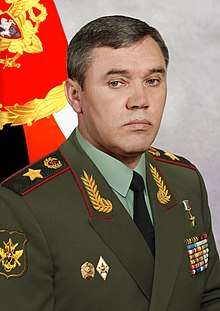
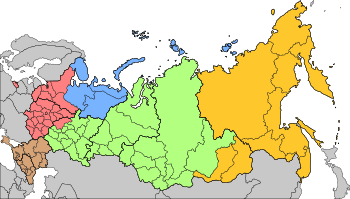
.png)
